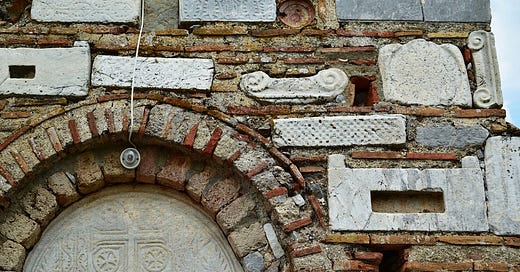This week we’re excavating amongst ruins, exploring antique spolia and a very 21st century lamp. Do bring a spade 🧱 ⛏
✨Enjoying Design Lobster? Please share it with a friend, colleague or fellow designer.
Question: What are spolia?
In cities and towns around the Eastern Mediterranean it is not uncommon to see churches and walls built with fragments of old temples or statuary. The re-use is frequently irreverent, a column sliced into banana slices or a capital on it’s side as shown above. These recycled fragments of old buildings are known as spolia, which comes from the Latin spolium meaning spoils, booty or loot.
Most often, the decision to re-use objects in this way was pragmatic, why quarry more stone, when pre-cut blocks were readily available nearby? But it also sometimes had symbolic or magical significance. Incorporating the fragments of old temples into new, was considered to incorporate the powers of their gods too.
Nowadays in the West we tend to treat historic objects and buildings with extreme reverence and care. When building next to historical structures we use materials like steel and glass to emphasise separateness rather than continuity. This can however make us feel less connected to history and less aware of where we’ve come from. I’d like to see more literal and figurative spolia in our designs.
Design takeaway: What fragments of old objects, systems or ideas does your design contain?
🧱 The Little Metropolis church in Athens is almost entirely built from spolia.
Object: (C)lamp
The novelist and design theorist Bruce Sterling designed this strange lamp in 2005 in collaboration with Anna Lena. Made exclusively from plastic table clamps, it forms an almost baroque silhouette, resembling a sort of cyberpunk jellyfish. It’s a dramatic transformation of something so mundane.
Bruce is fascinated by the passage of objects through time. From the process of conceiving and designing them, through to their everyday usage and beyond that their re-use and death. This lamp represents an exploration of that re-use, articulating a post-industrial aesthetic that reimagines waste as luxury.
Design takeaway: How could you re-use something everyday in your design?
📖 If you haven’t already read it, I highly recommend Bruce’s book Shaping Things
Quote: ““We build our computers the way we build our cities—over time, without a plan, on top of ruins.””
– Ellen Ullman
Ellen Ullman is an inspiring computer programmer and writer. This quote comes from her book Life in Code: A Personal History of Technology. It’s easy to think of computer code –and digital technology in general – as crisp and pristine like the laptops and phones that run it. In reality, code is as messy and cobbled together as the foundations of an old city.
Whatever you do, keep discovering.
Ben 🦞
Enjoyed this week’s Design Lobster? Let me know by clicking the heart button.
👇





